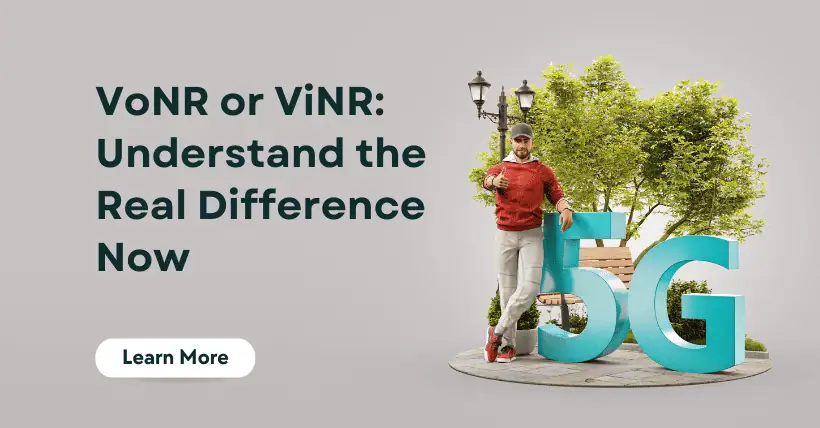In the vast ocean of 5G, two technical terms are quietly transforming our calling experience—VoNR (Voice over New Radio) and ViNR (Video over New Radio).
VoNR and ViNR represent voice calls and video calls in the 5G era, respectively. They greatly enrich our daily lives and further enhance our calling experience.
Have you ever wondered what phone calls will look like in the future? Will it be the seamless switching of VoNR, or the efficient innovation of ViNR? Let’s unveil their mysteries and explore the new wave of communication!
1. VoNR: A New Chapter in 5G Voice Calling
Concept Unveiled
VoNR enables voice calls to be handled directly over the 5G New Radio (NR) network, without falling back to the 4G network.
How It Works
Like driving on a highway, VoNR keeps your voice call entirely on the 5G lane, avoiding delays caused by switching lanes.
Development Path
2G/3G Era: Voice services used CS (Circuit Switched) technology.
☛ Required the phone to establish a dedicated line before a call and dismantle it after.
☛ Inefficient, complex networking, and resource-intensive.
Early 4G: Used CSFB (Circuit Switched Fallback). Phones would automatically fall back to 2G/3G to complete voice calls using CS technology and return to 4G after the call.
4G Era: Introduced VoLTE.
☛ Enabled IP-based voice services over the 4G network.
☛ Used AMR-WB high-resolution voice codec for clearer, wider voice frequency and improved transmission efficiency and quality.
5G Era: Uses VoNR.
☛ Provides voice services directly on a pure 5G IP network.
☛ Employs more efficient architectures and technologies, shortening call setup time and enhancing voice quality and encoding rates.
Advantages
From an efficiency perspective: Shorter call setup time, improved network efficiency, reduced operational costs, reuse of high-quality low-frequency resources, and enhanced call security.
From an application perspective: Supports concurrent 5G voice and data services—make calls while enjoying high-speed 5G internet. It also enables new 5G applications such as AR/VR and holography, which rely on real-time high-definition audio and video communication.
2. ViNR: A New Experience in 5G Video Calling
Basic Understanding
ViNR provides high-quality video calls over the 5G New Radio (NR) network.
Development Path
4G Era: Used ViLTE, an extension of VoLTE.
5G Era: Uses ViNR over 5G networks.
Advantages
From an efficiency perspective: Improves network efficiency.
From an application perspective: Enables new 5G applications such as AR/VR and holography, which require real-time HD audio and video communication.
3. What’s the Difference Between VoNR and ViNR?
Packet Interval
VoNR: During active voice transmission, adjacent RTP packets are spaced 20ms apart; during silence, spacing is fixed at 160ms.
ViNR: Video call packet intervals range between 0ms and 40ms.
(VoNR packets generally have a higher interval than ViNR!)
Packet Size
VoNR: For AMR-WB 23.85 voice codec, active RTP packets are typically 73 bytes; silent packets are about 19 bytes.
ViNR: Most video RTP packets are about 1153 bytes (around 70%).
(ViNR packets are significantly larger than VoNR!)
Bandwidth Requirements
VoNR:
☛ Fixed 20ms RTP packet interval, 50 packets per second. Each voice packet is about 86 bytes (byte-aligned, 688 bits).
☛ Therefore: VoNR voice rate = 688 × 50 / 1024 ≈ 34.4 kbps
ViNR:
☛ Each pixel = 2 bytes or 16 bits (YUV 4:2:2 sampling); per-frame data = resolution × 16 bits; frame rate = 30 fps.
☛ Compression: H.264 codec with ~1/150 compression rate. 150M of data compresses to 1M.
☛ Therefore: ViNR video rate = resolution × 16 × 30 × compression rate / 1024 kbps
☛ For 720P resolution: ViNR video rate = 720 × 1280 × 16 × 30 × 1 / 150 / 1024 = 2880 kbps
(ViNR requires significantly more bandwidth than VoNR!)
4. Conclusion
This article introduced you to the features and differences of VoNR and ViNR, both vital components of 5G communication technology.
Currently, voice calls remain mainstream in daily life, while video calls serve as a supplementary method, popular among some users. VoNR and ViNR are helping us enjoy a smarter, more convenient communication experience.
In the future, as communication networks continue to expand and improve, let’s wait and see how far the development of voice and video calling technologies will go.

Disclaimer:
- This channel does not make any representations or warranties regarding the availability, accuracy, timeliness, effectiveness, or completeness of any information posted. It hereby disclaims any liability or consequences arising from the use of the information.
- This channel is non-commercial and non-profit. The re-posted content does not signify endorsement of its views or responsibility for its authenticity. It does not intend to constitute any other guidance. This channel is not liable for any inaccuracies or errors in the re-posted or published information, directly or indirectly.
- Some data, materials, text, images, etc., used in this channel are sourced from the internet, and all reposts are duly credited to their sources. If you discover any work that infringes on your intellectual property rights or personal legal interests, please contact us, and we will promptly modify or remove it.



